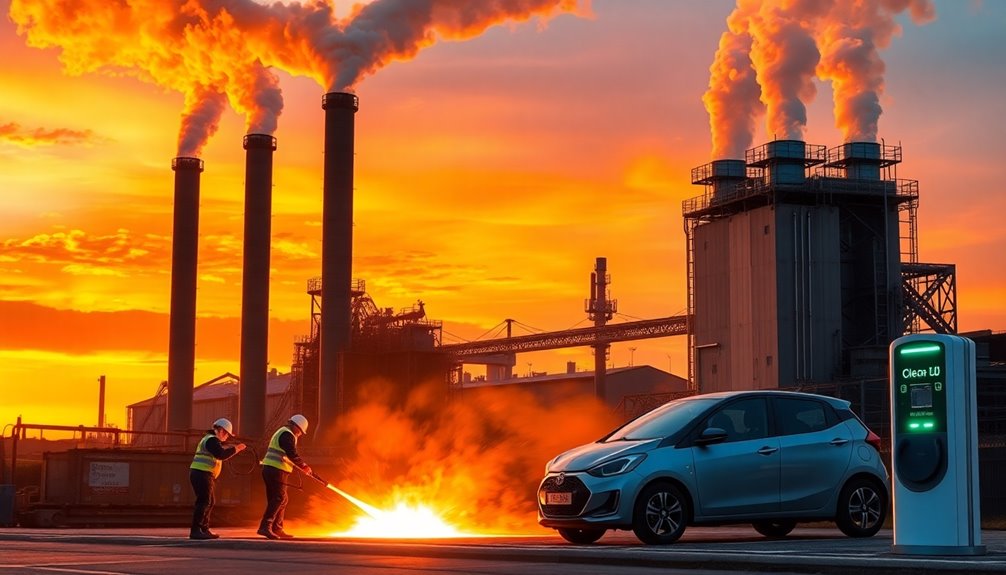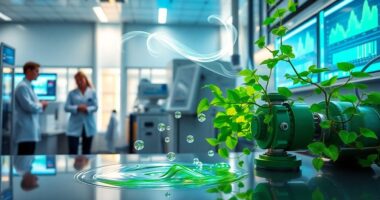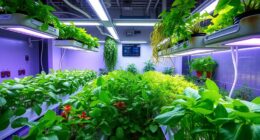The EU is betting on clean steel to reshape the future of heavy industry, targeting significant reductions in greenhouse gas emissions. By adopting innovative technologies like hydrogen-based production and electric arc furnaces, they aim to cut CO2 emissions by up to 95% by 2050. This shift not only supports environmental goals but also secures the strategic resilience of Europe's industrial sector. Discover how these efforts impact the broader economy and the transition process for workers.
Key Takeaways
- The EU aims for an 80-95% reduction in steel sector CO2 emissions by 2050, prioritizing clean steel technologies for future sustainability.
- Clean steel initiatives, supported by €700 million from Horizon Europe and €1 billion from the steel industry, enhance economic resilience and environmental goals.
- The steel industry, responsible for 5% of the EU's greenhouse gas emissions, is transitioning to hydrogen-based and electric arc technologies for greener production.
- The EU's regulatory framework, including the Steel and Metals Action Plan, protects domestic industries while promoting the shift to low-emission steelmaking.
- Investment in clean steel technologies secures the EU's strategic position in heavy industries and is crucial for military production capabilities.

As the EU embarks on its ambitious journey toward clean steel production, it's clear that innovative technologies and sustainable practices will play a pivotal role in transforming the industry. The Clean Steel Partnership (CSP) stands at the forefront of this initiative, aiming to decarbonize the European steel sector significantly. With a target to cut CO2 emissions by 80-95% from 1990 levels by 2050, the CSP draws on a robust funding framework of €700 million from Horizon Europe and an additional €1 billion from the steel sector.
The Clean Steel Partnership aims to significantly decarbonize the EU steel sector, targeting an 80-95% reduction in CO2 emissions by 2050.
You're likely aware that the steel industry is responsible for about 5% of the EU's total greenhouse gas emissions. Thus, it's crucial to invest in technologies that can reduce this footprint. Hydrogen-based technologies are being scaled up for green steel production, while electric arc furnaces (EAFs) increasingly dominate cleaner scrap-based steelmaking. A total of 171.6 projects are currently underway to advance clean steel initiatives, showcasing the industry's commitment to innovation.
Furthermore, integrating carbon capture, utilization, and storage (CCUS) into production processes is essential for minimizing emissions.
The shift toward a circular economy is equally vital. By valorizing by-products and enhancing resource efficiency, the industry can significantly reduce waste. Recycling renewable hydrogen not only supports climate neutrality but also aligns with smart carbon usage strategies that optimize materials and processes.
Digital tools are enhancing supply chain management, enabling better quality control in line with these circular economy principles.
The EU's Steel and Metals Action Plan (SMAP) underlies the regulatory framework, ensuring that clean steel production remains commercially viable. While phasing out coal-fired blast furnaces is one recommendation, protecting the EU steel industry's interests against unfair imports is also critical.
Investing in green steel technologies doesn't just align with environmental goals; it can also create resilience in the industrial value chain. As the steel industry transitions, it's vital to ensure a just process for workers, linking public funding to decarbonization commitments.
Clean steel isn't only about sustainability; it's about securing the EU's strategic future in heavy industries and military production.
Frequently Asked Questions
What Is the Timeline for Transitioning to Clean Steel Production?
You'll see a phased approach to transitioning to clean steel production.
In the short term, current technologies like electric arc furnaces will reduce emissions.
By 2025, hydrogen-based production projects will ramp up, marking your mid-term developments.
Long-term innovations, such as flash ironmaking, are also in the works.
The pace of this transition hinges on economic viability and clean energy availability, so keep an eye on those factors as the timeline progresses.
How Will Clean Steel Impact Job Opportunities in Heavy Industry?
Transitioning to clean steel will impact job opportunities in heavy industry like a butterfly emerging from its cocoon.
You'll see new roles in green manufacturing, focusing on renewable energy and carbon capture technologies.
While some traditional jobs may decline, reskilling and upskilling will pave the way for you to thrive in this evolving landscape.
Embracing training programs will help you adapt, ensuring you're equipped for the innovative opportunities that clean steel presents.
What Technologies Are Being Developed for Clean Steel Production?
You'll find several promising technologies in development for clean steel production.
Molten Oxide Electrolysis (MOE) uses renewable electricity to eliminate carbon emissions, while hydrogen-based direct reduction transforms iron ore into steel using hydrogen, producing only water vapor.
Electric Arc Furnaces (EAFs) melt scrap steel with renewable energy, reducing carbon intensity.
Additionally, Carbon Capture and Storage (CCS) captures emissions from existing plants, contributing to a cleaner steel industry and supporting sustainability efforts.
How Does Clean Steel Contribute to Eu's Climate Goals?
You mightn't realize it, but clean steel plays a crucial role in the EU's climate goals.
By significantly reducing CO2 emissions through innovative technologies like renewable hydrogen and carbon capture, it aligns with the ambitious target of an 80-95% reduction by 2050.
This shift not only fosters a sustainable steel industry but also promotes circular economy practices, enhancing resource efficiency and minimizing waste, ultimately driving the EU toward a greener future.
Are There Financial Incentives for Companies to Adopt Clean Steel Methods?
Yes, there are significant financial incentives for companies to adopt clean steel methods.
You can benefit from government subsidies, tax credits, and grants designed to support decarbonization efforts. In the EU, these incentives are often more substantial than in the U.S., encouraging investments in green technologies.
Conclusion
So, as the EU gears up to trade heavy industry for clean steel, you might want to grab a popcorn and watch the show. Who needs tanks when you can have eco-friendly, rust-resistant structures? It's like swapping a muscle car for a solar-powered scooter—sure, it's quieter, but good luck in a race! While the world's at war, let's hope those clean steel tanks come with a side of humor because laughter's the best armor in these times!









